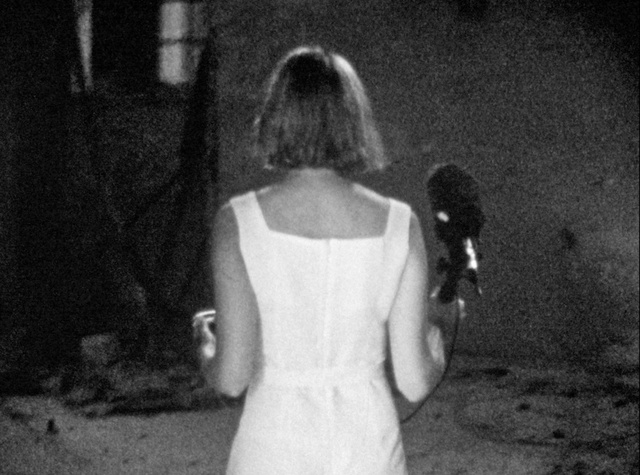Reviews
Basma Alsharif: The Doppelgänger
Berlin Documentary Forum 3 at Haus der Kulturen der Welt, Berlin
A young woman begins to speak in a darkened room. Gradually, a single light illuminates a figure sitting to the right of the screen clad in a bright, knee-skimming patterned t-shirt dress and shimmering silver shoes. A languid video flickers to her left as she speaks, layering accumulations of abstract textures. Occasionally, figures pierce these hazy color-fields flanked by snippets of text. While the video streams behind her, the woman introduces herself to the audience, briefly glossing her Palestinian parents' exile in Olympia, Washington, where she was conceived, and going on to trace the family's relocations to Kuwait, France, and the American Midwest in the years that followed.
Her tone then shifts mid-stream. A collective narrative suddenly elides the family's personal experience of the family: the Haganah, the Palestinian people, curtailment, savagery, rape, and death. Devoid of any regional inflection, the woman's flat American accent recalls the regionless dialect of American newscasters. Yet her voice and visage refuse to cooperate. Unlike an anchorperson, she fumbles slightly while reading, grimaces at times as if annoyed by what she sees, and squints to ascertain what lies on the page in front of her. One could mistake this for a simple case of performance jitters if she didn't cursorily flick the page beneath her sheaf of papers, commenting with an slight shake of her head, 'This isn't my story, I don't know how it got in there.'
Thus begins the cascading series of personal narratives, film and video clips, and bi-located performances that comprises Basma Alsharif's recent lecture performance The Doppelgänger (2014). True to its title, both the form and the content of Alsharif's performance posit a multitude of couplings: the personal and the political, the magical and the quotidian, the seen and the unseen, the screen and the stage. The term Doppelgänger entered literary discourse, and thus the popular imagination, through a footnote in a work by the German novelist Jean Paul (Richter) in 1796. So heissen die Leute, die sich selbst sehen: This is what people are called who see themselves. Indeed, although The Doppelgänger does at times engage Palestinian history, the bulk of the lecture performance concerns Alsharif herself: sharing anecdotes, familial history, and her rejection of the notion of a fixed Palestinian identity, as well as her ongoing research interest in the phenomenon of bilocation – the process of locating perception outside of the body and being in multiple places at once. After thirty minutes seated alongside the video screen, Alsharif rises to stand in the center of the screen. Binaural beats fill the theater, creating an electric ambience, while a wash of luminous color swells behind her. The combination of driving sound andpulsating imagery lulls the theater into a kind of collective hypnosis as Alsharif describes the co-existence of three landscapes as if she were viewing them from afar: a site, a model, and a ruin. The intensity of the sound and strobing lights peak as Alsharif vanishes from sight. She appears again onscreen, inhabiting the same scenes that she has just described.
In casting own story as the focal point of the performance, Alsharif activates the 'bundle' of perceptions that David Hume claims comprise the ever-shifting terrain of the self. In The Doppelgänger we hear about Basma the teenager, gaining her first citizenship at the age of thirteen; Basma the peripatetic artist, who is denied entry to the West Bank; we see Basma on stage talking to us – then we don't; We hear Basma's voice through the darkness; her back appears before us on screen, slowly walking ahead of us. Spawned from ancient myth and folklore, the double endures as an archetype in part because it resists definition. As a shadow self, the double emerges to haunt its host in times of stress and transition. Unlike its folkloric cousin, who is closer to a guardian angel, modern incarnations of the double in literature and cinema more frequently manifest as symptomatic of a fractured psyche, unsettling its beholder with the force of the repressed returning.
While Alsharif claims to be personally disinterested in identity politics, most likely because of the fact that its classical articulation often encourages mobilization around a single axis of identification that her own experience as a Kuwati-born Palestinian woman necessarily complicates. Yet, in thinking about the nomadic way in which she lives her life, the exploration of bi-location and the double in her work does take on a special relevance when considered within the Palestinian context. By focusing explicitly on how the body navigates space – both onscreen, onstage, and in the mind – Alsharif enacts an oblique protest against what she claims is one of the defining aspects of the modern Palestinian identity: the curtailment of movement. (Indeed, one of the leaflets Israel recently dropped during its most recent relentless bombing campaign against Gaza warned residents that 'Any moving body after noon will be struck.') Unlike an oppositional political stance, which directs its force against something concrete – whether a political party, social class, or religious group – the double conjures the limits of the thinkable, the sayable, and the actable. The transgressive quality of the double – its capacity to disrupt a social or political order – resides in its ability to inhabit multiple perspectives at once. The mutable quality of the double thus provides an oblique, chimerical political stance – particularly as it relates to the articulation and dispersal of Palestinian images.
The third Berlin Documentary Forum took place at Haus der Kulturen Welt, Berlin, from 29 May 29 to 1 June, 2014.
















